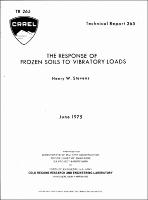Please use this identifier to cite or link to this item:
https://hdl.handle.net/11681/5659| Title: | The response of frozen soils to vibratory loads |
| Authors: | Stevens, Henry W. |
| Keywords: | Frozen soils Soils Soil mechanics Nonfrozen soils Soil properties Soil tests Soil physics Viscoelastic theory Vibration Flexural strength |
| Publisher: | Cold Regions Research and Engineering Laboratory (U.S.) Engineer Research and Development Center (U.S.) |
| Series/Report no.: | Technical report (Cold Regions Research and Engineering Laboratory (U.S.)) ; 265. |
| Description: | Technical Report Abstract: This study was conducted to provide reliable values of the stiffness and damping properties of frozen soils subjected to vibratory loads and to define the significant factors affecting these parameters. A laboratory test was conducted on prepared specimens of frozen soils wherein a right circular cylinder was subjected to steady-state sinusoidal vibration. The material was considered to be linearly viscoelastic. Analysis of test data based on one-dimensional wave propagation yielded the complex Young's modulus, the complex shear modulus, the phase velocity of wave propagation, the shear velocity, the damping property expressed as the angle representing time lag between stress and strain, an attenuation coefficient, and a complex Poisson's ratio. The frequency of vibration was varied from 500 to 10,000 Hz, and the peak dynamic stress was varied from 0.1 to 5.0 psi. Specimens were remolded or cored in-situ, frozen, and tested at temperatures of 0, +15 and +25°F. A few tests were conducted on identical soils nonfrozen. Test results from a limited number of tests on selected soils indicate that the stiffness of these soils varies with the volume of ice/volume of soil ratio, and that ice is less stiff than saturated frozen soils. Frozen soils have stiffnesses up to 100 times those of identical soils nonfrozen. Depending upon the degree of ice saturation, the stiffness of non-saturated frozen soils varies from that of the saturated soils to nearly that of the nonfrozen soils. Stiffness increases with decreasing temperature but the rate is relatively low. As temperature rises and approaches the freezing point, stiffness abruptly decreases. Damping, as a property of the material, does not differ greatly for frozen soil versus nonfrozen soil. This indicates that the mechanism influencing damping for frozen soil is quite different from that for nonfrozen soil. In the range of frequencies and stresses studied, the use of linear viscoelastic theory appears to be adequate for frozen soils, as only slight evidence of nonlinearity was observed. |
| Rights: | Approved for public release; distribution is unlimited. |
| URI: | http://hdl.handle.net/11681/5659 |
| Appears in Collections: | Technical Report |
Files in This Item:
| File | Description | Size | Format | |
|---|---|---|---|---|
| CRREL-Technical-Report-265.pdf | 5.28 MB | Adobe PDF |  View/Open |